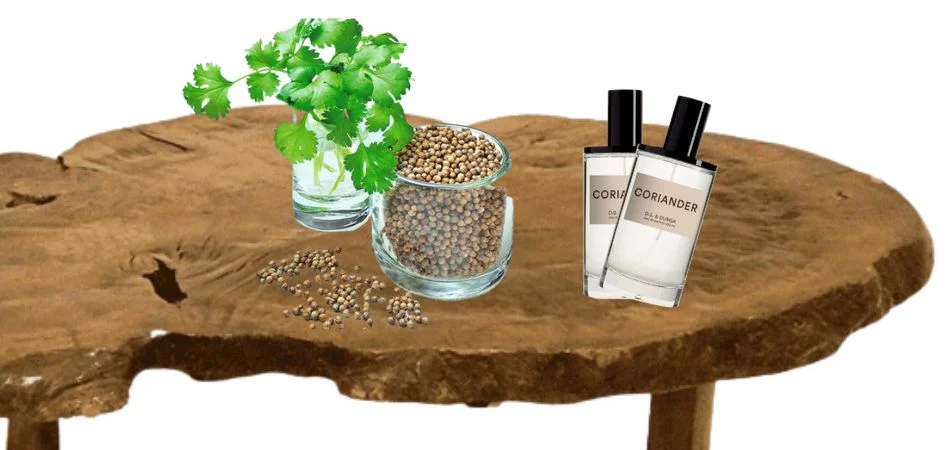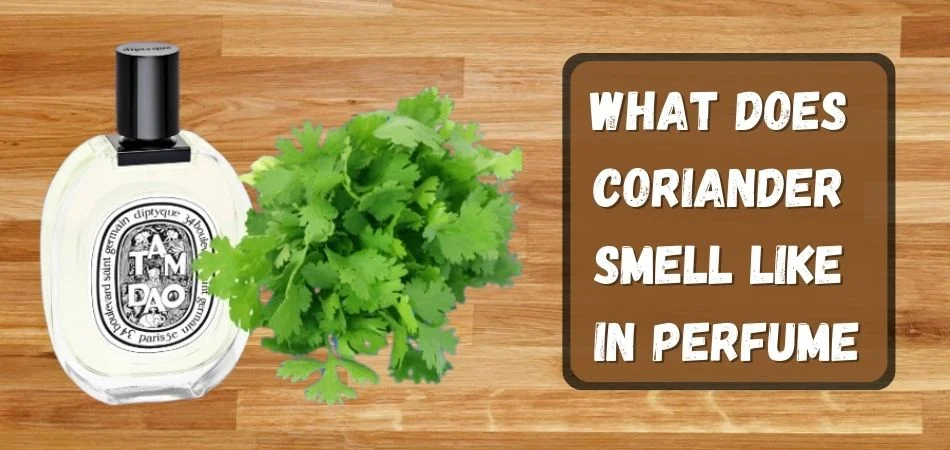Coriander in perfume emits a fresh, herbaceous, and slightly citrusy fragrance. It adds a subtle, spicy undertone, contributing to a well-balanced and complex scent profile when used as a fragrance note.
Highlighting its Use in the World of Perfumery
While its culinary and medicinal uses are well-known, coriander’s role in the world of perfumery is often understated. The seeds, especially, bring a unique, spicy, and slightly woody aroma that can add depth and complexity to fragrances.
When used judiciously, it can serve as an intriguing top or middle note, enhancing the overall olfactory experience and making the fragrance memorable.

Brief Overview of Coriander as a Culinary and Medicinal Herb
Coriander, often known as cilantro, particularly in the Americas, has been a cornerstone in various global cuisines for centuries. Its distinct flavor profiles – be it the leaves or the seeds – make it a favorite in a myriad of dishes.
But beyond the kitchen, coriander has also been lauded for its medicinal properties. It has been traditionally used in remedies for digestive issues, inflammation, and even cholesterol problems.
Its diverse uses have made it an integral part of both the culinary and health-focused cultures across the globe.
History of Coriander in Perfumery
Ancient Civilizations’ Use of Coriander in Scents and Balms
Coriander’s history in the world of scents traces back to ancient civilizations. The ancient Egyptians, for instance, incorporated coriander into their embalming rituals, hinting at its esteemed value.
Archeological excavations of Pharaoh Tutankhamun’s tomb unveiled pots filled with coriander seeds, a testament to its treasured status.
In other parts of the world, such as Ancient China and India, coriander was often blended into aromatic balms and potions, used both for therapeutic and aesthetic purposes.
Evolution of its Use in Modern Perfumes
Fast forward to modern times, and the legacy of coriander in perfumery remains steadfast. As perfumery evolved, so did the techniques to harness coriander’s distinct aroma.
With advanced distillation methods, perfumers have been able to capture the essence of coriander more effectively, leading to its use in numerous high-end and popular fragrances today.
Its scent, often described as a balanced blend of spice, citrus, and wood, provides a fresh yet warm note to perfumes. It is especially favored in oriental and spicy fragrance families.
Coriander: The Plant
Coriander is a herbaceous annual plant that belongs to the Apiaceae family. Characterized by its bright green, feathery leaves and small, round, beige seeds, this plant is often used both for its foliage and seeds in various culinary dishes.
The leaves, often referred to as cilantro, especially in the Americas, are soft with a somewhat serrated edge. They carry a fresh, slightly citrusy taste. The seeds, on the other hand, have a completely different flavor profile: they are more earthy, spicy, and slightly sweet.
While coriander is believed to have originated in the Mediterranean region, it has made its mark across various cultures and cuisines worldwide. Over time, it has found its home in diverse geographical landscapes.
Today, coriander is commonly grown in regions spanning from Southern Europe, Northern Africa, and Southwestern Asia. The adaptability of this plant means it can thrive in various climates, from the temperate zones of Europe to the tropical regions of Southeast Asia.
Coriander’s Olfactory Profile
When it comes to perfumery, coriander’s fragrance is as multifaceted as its taste. Distilled from the seeds, coriander oil unveils a spectrum of aromatic notes that can vary based on the region it’s sourced from, the method of extraction, and its maturity.
Top Notes: Bright, Citrusy Hints
Upon the first whiff of coriander essential oil, one is greeted with a fresh, bright burst reminiscent of citrus. This top note gives an uplifting and zesty aroma, making coriander a favorite choice for adding a touch of freshness to a fragrance.
Middle Notes: Slightly Spicy, Peppery, and Sweet
As the initial zestiness subsides, the heart of coriander’s scent starts to reveal itself. Here, it’s a beautiful blend of spice with subtle undertones of pepper and a touch of sweetness. This unique combination offers a tantalizing complexity, ensuring that the fragrance remains intriguing as it evolves on the skin.
Base Notes: Warm, Nutty, and Woody
As coriander’s scent reaches its full depth, the base notes emerge, grounding the fragrance with a warm, nutty, and slightly woody aroma. This gives longevity to the perfume, allowing the fragrance to have a well-rounded finish, providing depth and richness.
Interplay with Other Ingredients
Coriander, with its multifaceted olfactory profile, serves as a harmonious partner to various perfume ingredients, creating combinations that are both intriguing and captivating.
One popular pairing is with citrus ingredients, such as bergamot or lemon. These zesty elements amplify coriander’s bright, citrusy top notes, creating a refreshing burst that invigorates the senses.
On the other hand, when blended with floral ingredients like jasmine or rose, coriander’s spicy middle notes can accentuate the natural sweetness of the flowers, introducing an unexpected warmth and depth.
For those looking to create a more sensual or oriental fragrance, combining coriander with ingredients like amber, patchouli, or vanilla can be particularly effective. These ingredients complement the nutty, woody base notes of coriander, producing scents that are both rich and alluring.
As for famous perfumes that showcase coriander prominently, Calvin Klein’s “Obsession” for Men uses coriander alongside other spices, producing a scent that is intense, provocative, and enduring.
Another iconic perfume, “Dioressence” by Christian Dior, features coriander in a mélange with floral and oriental notes, resulting in a fragrance that is at once exotic and timeless.
The Psychological Impact
Scents have an incredible ability to transport us, to evoke memories, feelings, and even distant places. Coriander, with its rich and varied aroma, is no exception.
The bright, citrusy top notes of coriander can elicit feelings of freshness, vitality, and awakening. It’s the scent of new beginnings, of mornings when the world seems full of promise.
For many, it can also invoke memories of exotic markets and travel adventures, of places where coriander wafts in the air, mingling with other spices.
The spicy, peppery middle notes, on the other hand, can evoke warmth, comfort, and a touch of the exotic. It’s reminiscent of cozy winter evenings, of shared meals with loved ones, of laughter and connection. And as for the warm, nutty base notes? They speak of depth, of mystery, of stories whispered in hushed tones.
Perfumers, aware of this deep psychological impact, often employ coriander strategically in their creations. If they wish to convey a message of adventure and wanderlust, coriander can be a key player. If they’re looking to create an aura of intimacy and warmth, coriander lends itself beautifully.
Differing Perceptions
While coriander is appreciated for its unique aroma by many, it’s essential to acknowledge that olfactory experiences can be subjective and vary among individuals.
Addressing the Genetic Factor: Why Coriander Might Smell Differently to Some People
For some, coriander’s scent might not be as pleasant. Studies have found a genetic link among individuals who perceive a soap-like or off-putting odor when encountering coriander. This genetic variation affects a group of olfactory-receptor genes that influence an individual’s ability to detect specific chemicals found in coriander.
Cultural Contexts and Associations with the Scent of Coriander
Across cultures, coriander evokes varied responses based on culinary and traditional uses. In regions where coriander is a staple ingredient, the aroma is typically associated with warmth, home, and comforting meals. In contrast, cultures less familiar with coriander might find its scent exotic or unusual.
Ways to Experience Coriander in Perfumery
DIY: Making Your Own Coriander-Based Perfume at Home
Embrace the perfumer in you by crafting a personalized coriander-based fragrance. Start with a carrier oil like jojoba or almond oil. Add a few drops of coriander essential oil, ensuring it’s the star of your concoction. Layer in complementary essential oils like bergamot for freshness or patchouli for depth. Experiment, adjust, and discover a blend that resonates with you.
Recommendations for Popular Coriander-Centric Commercial Perfumes
Beyond DIY, numerous renowned fragrances champion coriander. “Eau d’Issey” by Issey Miyake and “Coco Mademoiselle ” by Chanel feature coriander as a keynote, offering consumers an effortless way to experience its charm.
Conclusion
Coriander, with its kaleidoscope of olfactory notes, remains an enigma in the world of perfumery. Its capacity to evoke memories, create associations, and define moments is unparalleled.
As with any fragrance note, it’s an invitation to journey – to explore, embrace, and even challenge sensory perceptions. For those adventurous at heart, the world of coriander awaits.
Additional Resources
Books, Websites, and Courses on Perfumery for Those Interested in Diving Deeper
- “The Secret of Scent” by Luca Turin offers a dive into the science and art of perfume creation.
- Basenotes.net is an online community where enthusiasts discuss and review various fragrances.
- The Institute for Art and Olfaction offers courses and workshops for budding perfumers.
Places to Purchase Quality Coriander Essential Oil or Perfumes
- Essential Oil Wizardry and Eden Botanicals provide a wide range of pure essential oils, including coriander.
- Fragrance stores like Sephora, Neiman Marcus, or niche boutiques often carry a curated selection of coriander-centric perfumes.


